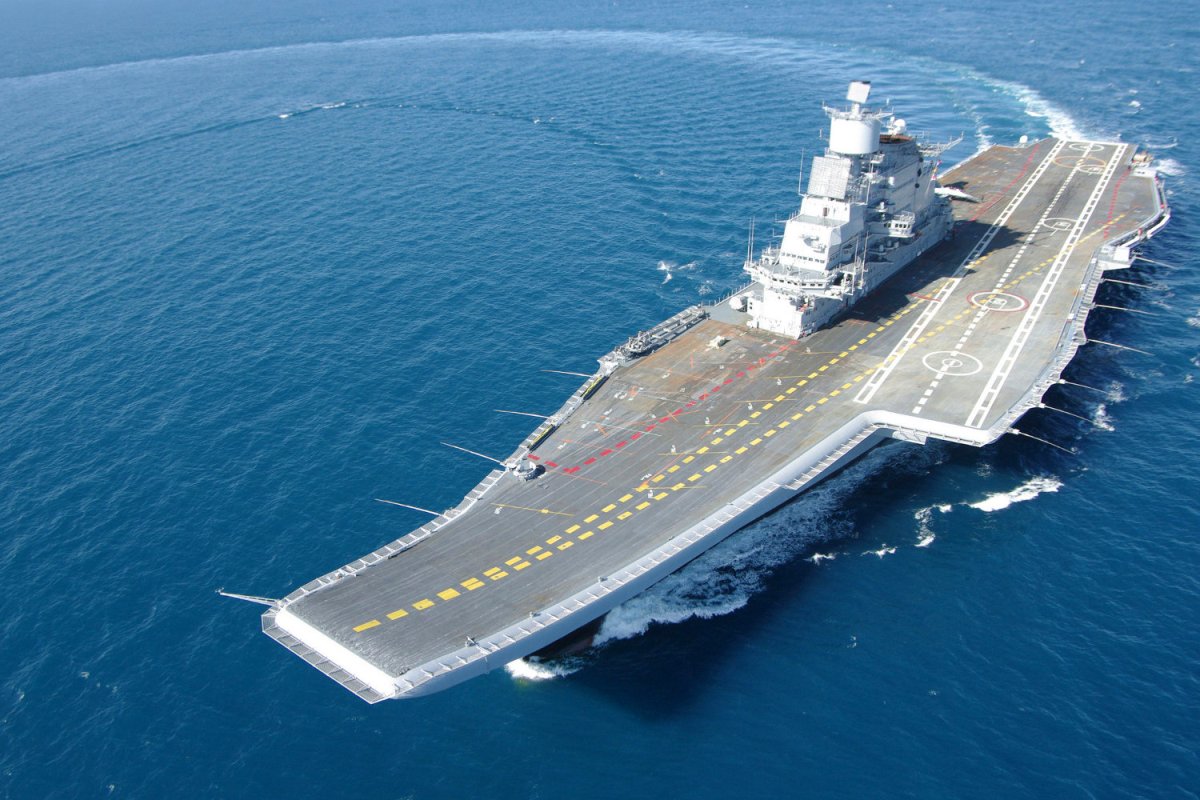On 12 May 2020, the PM of India raised a clarion call to the nation giving a kick start to the ‘Atmanirbharta Abhiyaan’ (Self-reliant India campaign) and announced the special economic and comprehensive package. The campaign for defence aims to provide financial assistance to Indian companies to develop and manufacture defence equipment and systems.
While the country had set up DRDO labs, Public Sector Units and Ordinance factories soon after Independence to manufacture equipment for defence, most of our Defence platforms in the sixties and seventies were imported from the USSR and Western countries. Indian Navy had most of its ships bought from the Royal Navy. We had major imports of ships and Submarines from the erstwhile USSR in the early seventies. However, the Navy started its indigenisation drive by setting up its design and production Directorate to build ships in our own shipyards. The first Leander class Naval Frigate INS Nilgiri was constructed at MDL in the early seventies with design help from the UK. This was followed by the building of six ships of the class at MDL. Naval Design Bureau since then have designed many ships and today we have about 67 ships under Construction in various shipyards in the country. These ships have large indigenous content and most of the systems, weapons and sensors have been designed by DRDO and produced by the Public and Private Industry in the Country. However, critical weapons and sensors, not available through local resources were imported from global majors and integrated onboard ships by our Weapons and Electronic System Engineering Establishment (WESEE) which was set up in the early seventies along with the Ship Design Bureau.
All these agencies have contributed immensely to achieving our self-reliance goals. However, the pace of development has not been commensurate with the requirement of the three Services leading to inescapable imports to meet the operational requirements. India thus has been the largest importer of Defence Equipment over a few decades and even today we are the fourth largest importer of defence equipment.
To reverse this trend, “Atmanirbharta in Defense”, a major initiative was launched by the Government of India in 2018 to enhance domestic manufacturing, reduce imports, and become a net exporter in the field of Defense. The above Key institutional and policy changes have spurred defence indigenisation, domestic capital procurement and defence exports. Moreover, in an era of uncertainty, the “Atmanirbhar Bharat” and “Make in India” policies have become a necessity to mitigate risks on account of disruption or manipulation of critical supply chains as seen in the Ukraine conflict with Russia.
Indigenization Policy Initiatives
The Defense Acquisition Procedure (DAP) 2020 has prescribed 50 per cent indigenous content in all procurement contracts. To encourage foreign original equipment manufacturers (OEMs) to set up manufacturing facilities in India, a new procurement category — Buy Global-Manufacture in India — has been introduced. The Union Ministry of Defense has released several “Positive Indigenization Lists” that mention items that must be procured only from domestic sources.
The Srijan Indigenization Portal was launched in August 2020. Over 34,000 items currently being imported have been uploaded on the portal — a third of them are already in the process of being indigenized.
The two industrial corridors established in Tamil Nadu and Uttar Pradesh have attracted major investments from Foreign OEMs to manufacture Defense Equipment in India. Apart from shipbuilding, there is an equal focus on the development of missiles, long-range artillery guns, multi-barrel rocket launchers and tanks, advanced radars, sensors, and electronic capabilities.
The Centre has stipulated that a sizable portion of the defence capital procurement budget should be diverted to the domestic defence industry. From 2020-21, the capital acquisition budget for domestic procurement has risen from around 40 per cent of the total capital procurement budget (Rs 52,000 crore) to 75 per cent (Rs 99,223 crore) in 2023-24. As a result of these initiatives, the value of India’s defence production crossed the Rs 1,00,000 crore mark for the first time in the fiscal year 2022-23 and is expected to reach Rs 1,75,000 crore by 2025.
The Innovations for Defense Excellence (iDEX) initiative, launched in 2018, aims to involve industry, including MSMEs, start-ups, R&D institutes, and academia. The iDEX Prime framework was launched in 2022 to support start-ups with grants-in-aid up to Rs 10 crore to enable the development of high-end solutions. Funding under the Technology Development Fund (TDF) scheme has been enhanced from Rs 10 crore to Rs 50 crore per project. A quarter of the defence R&D budget in 2023-24 has also been earmarked for academia and private industry. The goal of Viksit Bharat (developed India) by 2047 requires the defence sector to be more resilient and self-reliant.
Ship Building Capabilities
Indian Defence and Public and Private shipyards have proved their strength in building all types of ships from FPVs and OPVs to Frigates and Destroyers. Even the building of the first Indigenous Aircraft carrier is a matter of immense pride for the Nation. At present about 67 ships are under construction in various shipyards. The country can build ships to meet the Navy’s requirements to maintain a fleet strength of about 200 ships and Submarines. As far as submarine Production is concerned, MDL has built SSKs and Scorpion Class submarines with Technology help from the OEMs in Germany and France. The forthcoming P75 (I) project is also largely dependent on the Strategic technology partnership with the shipbuilders abroad. We need to buy the design capabilities to build these complex platforms and indigenise some of the critical Electric propulsion systems including Air Independent Propulsion (AIP).
Our strategic project to build nuclear Submarines is on track and we are building these vessels at Vizag with help from Russia. Building nuclear Attack Submarines is under active consideration under the program. All these projects require exceptionally large capital outlay and therefore take time to complete from start to design to construction to the system integration, trials and Commissioning.
Over the years, all the shipbuilding yards have upgraded and can build any type of vessel given the design. A private yard like L&T has state-of-the-art design, construction and repair facilities which have attracted some of the leading Western Navies for repair and logistics support recently.
Indigenisation of Weapons, Sensors and Command & Control systems
There are certain critical systems which must be made in-house, these include Ship Command and Control System, ship data Link, Electronic Warfare System, and Integrated Communication Systems. The Navy has already achieved remarkable success in developing these systems with DRDO, DPSUs, local private sector Defence industry. Some of these systems have been developed with know-how gotten through training of seed teams and launching development projects of these systems in the eighties and Nineties. Most of the ships have all these indigenous systems in different configurations. Here WESEE has played a pioneering role in System design of the Combat management system and diverse weapons and sensor system integration.
DRDO and DPSUs started indigenising weapons and sensor systems fitted on board ships from the mid-sixties onwards. Initially, Licence production of systems was taken up with the shipbuilding programs. Most of the radar and Display Systems, weapons and sensors were produced at BEL for the Leander class ships under licence manufacture. Gradually these systems have been indigenised. Almost all military communication and electronic warfare systems are being produced by BEL and ITI.
DRDO labs also took up many critical systems for design and development, which were productions by the DPSUs. Some critical systems not available through Indigenous sources were bought from abroad, mostly Russia and some Western countries and integrated with the Combat management system by WESEE. Some of the major Systems indigenised are listed below:
Communication and Electronic Warfare
All UHF, VHF, HF, and satellite communication systems onboard ships are indigenous and supplied by BEL and ITI for the Army Navy and Air Force. Electronic warfare systems earlier bought from Italy have been indigenised by DRDO and BEL.
Radars
All X-band, S-band and L-band radars earlier manufactured by BEL under licence production have been indigenised. 3D Stabilised phased array Radars like AMDR for anti-missile Defence Systems Barak have been acquired from Israel.
Missiles and Guns
The Barak system fitted on lead ships was imported from Israel, but The LR SAM and MR SAM have been developed by DRDO with TOT from Israel and inducted in newer ships. Brahmo’s missile system developed with TOT from Russia has been indigenised and fitted on all major ships with vertical launchers. Naval Long-range Guns have been indigenised and produced by BHEL. Short-range Guns are also being manufactured in the country.
Underwater Systems
The Navy launched a sonar development project soon after the 1971 war and DRDO lab NPOL designed and developed a world-class hull-mounted sonar APSOH under the leadership of Dr A Paulraj in the eighties. The system was produced by BEL and since then all Naval ships have been fitted with Indigenous Sonar APSOH and its derivatives. NPOL also developed a hull-mounted and variable depth Sonar HM- VDS for larger ships.
NPOL has also developed Towed array Sonars and Sonars for the Submarines. All these are under production at BEL. Underwater Towed Decoys (TOTED) have also been developed by NPOL and produced by BEL. A Torpedo Tube Launcher (TTL) has been developed by L&T and fitted on all ships. Ship-launched lightweight Torpedo has been developed by NSTL and produced by BDL and inducted in service. Submarine-launched Torpedoes are still being imported.
Combat Management System (CMS)
CMS fitted on the ship’s Operation Room is the Central Command and Control System integrated with all Sensors and Weapons onboard the ship for Detection and Tracking of all targets around it. It also does threat assessment and Weapon assignment for automatic engagement. This system was initially imported from Italy and later indigenised by the team associated with the system software development in Italy. The System is jointly designed by WESEE and BEL and all ships are fitted with the Indigenously designed CMS.
Tactical data Link
The tactical data link connected the CMS of ships at sea in a secure mode. It can also be linked to ships and Command centres ashore through the Naval satellite. This is a crucial system for network-centric warfare and has been indigenised.
Ship Data Bus
The ship’s CMS and navigational systems are required to exchange data and information with all weapons and Sensors. These systems are connected through a Tripple redundant data bus designed by WESEE and produced by BEL.
Ship Propulsion and Engineering Systems
The ship has a large number of Electrical and Marine Engineering systems, including Main propulsion, Power Generation and Distribution, Ventilation and Airconditioning, Firefighting and Damage control, Conversion machinery, Inertial navigation system, Internal Communication and Broadcast system etc. Main propulsion and Auxiliary systems including main Turbines and Main Gears, Pumps and valves, Air Compressors, shafts and Propellors, Auxiliary systems and Controls etc. All these systems are also centrally Controlled through the Integrated Power Management System (IPMS). Most of these systems have been indigenised, except for main propulsion systems, like LM 2500 Turbines and systems imported from Russia. These systems need to be made in India through licence production and TOT.
Drones, Autonomous Vessels, and Platforms
Developments of Drones, Unmanned Air Vehicles (UAV) Unmanned ships and Crafts and Unmanned Underwater Vehicles (UUVs) have completely transformed modern warfare. Surveillance and Weaponised Drones are the forefront weapons of today and can be deployed over long ranges with smart weapons of pinpointing accuracy. Russia Ukraine war and Israel conflict have demonstrated how the Autonomous systems can destroy the targets of choice. These platforms have the most advanced sensors for surveillance and detection and are remotely controlled to fire their weapons from their command centres. This technology has accelerated the Unmanned system design and development for Air, Surface and Sub Surface domains and all nations are engaged in improving the design of these lethal systems.
The race for more lethal ballistic and Cruise Missiles, undetectable weaponised Drones and Anti-Missile Defence systems capable of intercepting these Missiles and Drones is hot and one is trying to beat the other. A recent example of the Iran attack on Israel and the neutralisation of over 350 missiles and Drones is a case in point. Two recent announcements of Australia’s “Ghost Shark” unmanned underwater Drone and US “Monster Manta Ray” show how Underwater domain awareness and Surveillance and ultimate warfare is going to shape the weapons of the future.
Australia‘s Ghost Shark Unmanned Sub
Unmanned small ships and crafts fitted with advanced AI-based sensors deployed in large numbers for patrolling the coastlines shall soon become a reality and supplement today’s manned ships and Submarines. Unmanned underwater Drones shall monitor the seas and the remote Command stations Connected with them will be able to identify the potential enemy targets, which could be engaged with manned and Unmanned ships and Drones.
US Manta-Ray Underwater Drone
IN Capabilities in Unmanned Systems.
GSL has recently launched a small Autonomous vessel. There shall be a large requirement of such ships with Autonomous navigation and control for patrolling and surveillance in the future. Similarly, the requirement for Autonomous Underwater vehicles (AUV) shall grow with the advancement of such ships in Surveillance and remote patrolling of the seas in Air, Surface, and Sub Surface. The new sensors and weapons for such vessels will have to be designed and developed based on current technologies and emerging AI-based sensors for target characterisation. The present defence Industry including many startups can certainly venture into these high-technology areas.
High-speed networking is a critical component in all Autonomous vessels in the air, surface and Underwater. With many platforms connected through Data links including Satellite links, Cyber and Network security shall be equally challenging.
Self-Reliance in Naval Defence.
The Navy has made Considerable progress in the Indigenisation of most of the systems and subsystems required for Ships, Submarines, and marine aircraft.
However, with the technological revolution in Autonomous systems, advanced Weapons and Sensors, High-speed Computing and secure Communications in a completely networked environment, all platforms and their systems are evolving. While we can say that indigenous content is more than 80% on the new ships, we cannot afford the technology gap to widen with the new development of the Global majors. We therefore require constant effort to design comparable systems with the advanced nations and develop the systems for which we are still dependent on imports. Some of the areas which require our Public and Private industry to address are as follows:
- Marine Propulsion Systems for ships, Submarines and aircraft including Electrical Propulsion Systems for ships.
- Autonomous platforms/ Drones for Air, Surface, and Underwater Domains and integration of these systems with the manned systems and Command Centres.
- Naval Aviation platforms, fighter jets and Multirole Helicopters
- Hypersonic Missiles
- Optical Sensors and High energy Weapon systems
- AI-based smart Sensors and Weapons
- Space-based Surveillance and tracking
- Secure Communication and Networks for Joint warfare
- 3 D Surveillance radars .
- Apart from the gaps in the above areas, we need to continuously improve the design of systems already indigenised with the advancements in technology, quantum computing, Artificial Intelligence sensors and Weapons, Unmanned systems and so on.
Conclusions:
Indian Navy has made considerable progress in Indigenisation and self-reliance and the shipbuilding capacity is adequate to maintain a fleet of about 200 ships and Submarines. Most of the equipment, including weapons and sensors has been indigenised. Govt thrust on Atmnirbharta has accelerated the development and manufacture of Defence systems in the country. We still have some gaps which are being filled with Technology partnerships from abroad. Technology revolution in Unmanned platforms has further increased the demand for developing unmanned vessels for Air, Surface, and Underwater warfare. The race for hypersonic Missiles and defence against them, the ever-smart AI weapons and sensors, high energy weapon systems and propulsion systems would require continuous long-term efforts to compete with the development around the world. The self-reliance index is dependent upon the threat perception and with our neighbours, we have no options but to continuously develop capabilities commensurate with them to defend ourselves. Our Policy of Atmnirbharta shall enable us to manufacture the equipment and Systems for our defence forces and also enable us to become a net exporter of defence equipment.
Title Image Courtesy: https://www.thestatesman.com/
Disclaimer: The views and opinions expressed by the author do not necessarily reflect the views of the Government of India and Defence Research and Studies









